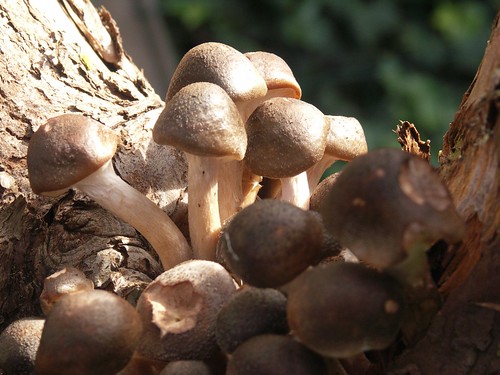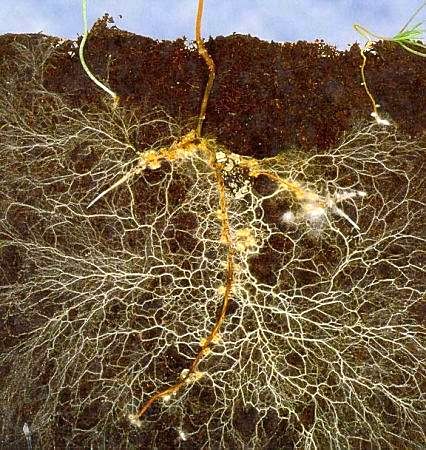 |
| Hint: it lives here. (Malheur National Park, OR) Photo credit: Karl S Johnson |
You’ve never seen more than a few inches of the mysterious organism's full length at a time, but perhaps that’s just because you haven’t been looking in the right place: in the dirt of Oregon’s Malheur National Forest, where the fungus Armillaria solidipes shoots forth thread-like mycelia for over 2,000 acres beneath our feet. The tiny, visible bits are honey mushrooms peeking out from the bark of nearby trees. In the last two millennia, this fungus has slowly taken over Oregon’s subterranean world. Now fungi of all sorts are taking over our world above the ground.
 |
| Honey mushrooms of the fungus Armillaria solidipes, which sprout from the floor of Malheur National Forest in Oregon. Photo credit: Badly Drawn Dad |
The fuss about fungi
As a botany student, I’m always gushing about the cool things that plants can do. But fungi deserve credit for allowing a lot of those things to happen via a mutualistic symbiosis they form with plant roots. This symbiotic relationship is called a mycorhizza (Sara covered this topic the other day), and it’s actually vital to the crops that we depend upon. Mycorrhizae improve soil chemistry, and they offer drought and pathogen resistance to the partner plants they latch onto. Because branching fungal hyphae are thinner than the most slender plant roots, they can also provide a large surface area for the plant’s absorption of minerals, like phosphate, from the soil. All they ask in return is a little sweetness from the plants, who happily share their sugar supply.
Why should you care about how a plant gets its phosphate? Phosphorous is currently a major fertilizer component. But like many other modern conveniences, our supply of it is quickly dwindling. It would seem that agriculture faces quite a problem. The good news is that fungi might be able to help us out on this one.
Why should you care about how a plant gets its phosphate? Phosphorous is currently a major fertilizer component. But like many other modern conveniences, our supply of it is quickly dwindling. It would seem that agriculture faces quite a problem. The good news is that fungi might be able to help us out on this one.

- Mycorrhizae on a plant root
Not long ago, a team of researchers started with a mycorrhizal fungus known to inhibit growth of rice crops.The cells of these fungal hyphae contain many nuclei when most cells only have one (in case you missed that, they have multiple genomes. I highly recommend the explanatory videos found here). They determined that the random assortment of these genetically diverse nuclei into spores could produce novel strains of offspring. Incredibly, these offspring affected symbiotic relationships with the rice and improved their growth up to five times. This has opened up the possibility of ‘designer mycorrhizae’ –blends of crop-specific fungi engineered to improve absorption of less accessible phosphate (and other nutrients) naturally. If successful, it would lessen our burden to mass produce and apply inorganic fertilizers, which can linger in the soil and disrupt environmental and ecological balances.
Cleaning up our messes
For the terrible messes of chemicals we've already used but don't know how to degrade, we have begun to turn in the direction of something called mycoremediation. A team of researchers started with three piles of trash covered in petroleum to simulate an oil spill. To one pile, they applied enzymes; to the second, bacteria. Then they added oyster mushroom mycelium to the final stack of grimy trash, covered all the piles, and waited. When the tarps were removed 8 weeks later, the first two piles showed no change. But the last pile, according to mycologist and all-around-interesting-personality Paul Stamets, “was a green berm of life.” Mushrooms had formed spores, and the spores had attracted insects, then birds, then seeds. The carcinogenic hydrocarbons from the fuel had been reduced by 98%. Stamets discusses several other potential uses for his fungal cultures in an excellent TED talk, which can be found here.
Also on the TED sphere are a couple of young entrepreneurs who have developed an innovative system for shipping your fragile items without the guilt of filling landfills with petroleum-based products for thousands of years. If you can’t guess what sort of biological material it uses by now, you clearly haven’t been paying attention. Mycobond packaging takes local crop waste like seed husks and adds a blend of mushroom spores. The pulp is placed into a mold, and within 5 days a Styrofoam alternative emerges. When you’re done using it, you can compost it and create healthier soil for your own use.
Killer fungi and zombie ants
Fungi help us to grow things and to restore life to habitats that would otherwise be ruined. But what about when we need help killing things? No problem, at least not for a particularly fascinating group called the entomopathogenic fungi. These varieties paralyze or kill insects, offering a valuable naturally-occurring pesticide. I love this video from the BBC. It explores the sneaky Cordyceps unilaterus as it controls insect populations along the rainforest floor. The fungus commandeers the insect’s body and compels it to climb to higher ground for maximum distribution of spores after germination.

- "Zombie ant" infected with Cordyceps fungus
Image by David Hughes
Ants try to quarantine the members showing early neurological signs of spore infection, but oftentimes it’s too late and entire colonies can be wiped out. A former bustling colony becomes a graveyard of victims eerily frozen in time, still clinging to leaves but now with strange, delicate little mushrooms sprouting from their heads and abdomens.
Paul Stamets had a problem with ants –not in the jungles of Brazil, but in his house. He knew that a certain type of entomopathogenic fungus could repel carpenter ants and termites with its spores. A dish of the fungus wouldn’t work as a bait, because the insects would avoid it. So, he made a non-sporulating form in his lab. The ants ate it up, and the problem solved itself. But it didn’t end there. The tiny mushrooms that subsequently sprouted from the bodies of the insect corpses did eventually sporulate, and those spores effectively prevented reinvasion by other ant colonies. That makes this fungus an extremely effective, long-term, and environmentally preferable solution to chemical pesticides.
Fungi may represent a means of living sustainably, intelligently, and inventively in the future. The biological processes that guide their lives are strange and wonderful ones carrying on beneath our feet, beneath our forests, and (sometimes) beneath our line of sight. But take a moment to observe them and I think you’ll be pleasantly surprised.


I love that picture of mycorrhiza on the roots of the plant. Also, related to Cordyceps, I once read about this plant that would essentially cause a person to black out if he/she ingested it. People would do silly things like move all of the furniture out of their houses while under the accidental influence of the plant. Then, several hours later, they would be back to normal (and have to move the furniture back inside). I cannot find the name of the plant, unfortunately.
ReplyDelete